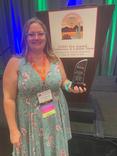| Date | Title |
|---|---|
| 06/18/2025 | |
| 03/27/2025 |

Featured
|
| 02/01/2025 | |
| 10/16/2024 | |
| 10/16/2024 | |
| 10/09/2024 | |
| 06/12/2024 | |
| 06/05/2024 | |
| 04/03/2024 | |
| 12/11/2023 | |
| 10/18/2023 | |
| 09/13/2023 | |
| 09/08/2023 | |
| 11/10/2022 | |
| 09/29/2022 | |
| 07/16/2022 | |
| 11/04/2021 | |
| 11/01/2021 | |
| 08/29/2021 | |
| 06/17/2021 | |
| 05/10/2021 | |
| 04/23/2021 | |
| 03/09/2021 | |
| 12/09/2020 | |
| 12/09/2020 | |
| 12/03/2020 | |
| 10/02/2020 | |
| 10/02/2020 | |
| 10/01/2020 | |
| 10/01/2020 | |
| 10/01/2020 | |
| 09/21/2020 | |
| 08/12/2020 | |
| 08/12/2020 | |
| 08/03/2020 | |
| 06/15/2020 | |
| 05/04/2020 | |
| 04/09/2020 | |
| 02/19/2020 | |
| 01/27/2020 | |
| 11/28/2019 | |
| 09/11/2019 | |
| 08/27/2019 | |
| 08/16/2019 | |
| 07/29/2019 | |
| 04/11/2019 | |
| 02/11/2019 | |
| 10/25/2018 | |
| 06/18/2018 | |
| 06/08/2018 | |
| 06/06/2018 | |
| 05/10/2018 | |
| 01/25/2018 | |
| 01/03/2018 | |
| 11/15/2017 | |
| 11/13/2017 | |
| 09/20/2017 | |
| 09/10/2017 | |
| 08/04/2017 | |
| 08/02/2017 | |
| 06/26/2017 | |
| 12/08/2016 | |
| 12/08/2016 | |
| 08/18/2016 | |
| 08/17/2016 | |
| 06/30/2016 | |
| 06/15/2016 | |
| 05/02/2016 | |
| 04/20/2016 | |
| 03/31/2016 | |
| 03/28/2016 | |
| 03/12/2016 | |
| 12/04/2015 | |
| 11/30/2015 | |
| 11/25/2015 | |
| 11/23/2015 | |
| 11/18/2015 | |
| 10/27/2015 | |
| 10/05/2015 | |
| 10/01/2015 | |
| 09/14/2015 | |
| 04/29/2015 | |
| 04/16/2015 | |
| 04/10/2015 | |
| 04/03/2015 | |
| 03/24/2015 | |
| 03/06/2015 | |
| 03/06/2015 | |
| 03/02/2015 | |
| 01/20/2015 | |
| 12/12/2014 | |
| 11/03/2014 | |
| 10/01/2014 | |
| 09/23/2014 | |
| 08/25/2014 | |
| 08/12/2014 | |
| 07/31/2014 | |
| 07/02/2014 | |
| 06/27/2014 | |
| 06/26/2014 | |
| 06/16/2014 | |
| 06/09/2014 | |
| 03/27/2014 | |
| 03/17/2014 | |
| 03/12/2014 | |
| 02/01/2014 | |
| 01/31/2014 | |
| 01/22/2014 | |
| 01/09/2014 | |
| 01/08/2014 | |
| 12/10/2013 | |
| 11/26/2013 | |
| 11/22/2013 | |
| 11/20/2013 | |
| 11/06/2013 | |
| 11/04/2013 | |
| 10/28/2013 | |
| 10/16/2013 | |
| 10/03/2013 | |
| 10/02/2013 | |
| 09/26/2013 | |
| 09/21/2013 | |
| 09/16/2013 | |
| 09/05/2013 | |
| 08/28/2013 | |
| 08/27/2013 | |
| 08/21/2013 | |
| 08/20/2013 | |
| 08/01/2013 | |
| 07/22/2013 | |
| 07/15/2013 | |
| 07/01/2013 | |
| 06/18/2013 | |
| 06/06/2013 | |
| 10/06/2012 | |
| 10/05/2012 | |
| 09/28/2012 | |
| 08/09/2012 | |
| 08/01/2012 | |
| 07/25/2012 | |
| 05/25/2012 | |
| 05/21/2012 | |
| 05/21/2012 | |
| 05/10/2012 | |
| 03/15/2012 | |
| 02/01/2012 | |
| 01/31/2012 | |
| 12/21/2011 | |
| 12/20/2011 | |
| 12/20/2011 | |
| 12/13/2011 | |
| 11/26/2011 | |
| 11/25/2011 | |
| 11/16/2011 | |
| 11/16/2011 | |
| 11/16/2011 | |
| 10/27/2011 | |
| 10/19/2011 | |
| 10/17/2011 | |
| 10/03/2011 | |
| 09/22/2011 | |
| 09/19/2011 | |
| 09/13/2011 | |
| 08/19/2011 | |
| 07/25/2011 | |
| 07/22/2011 | |
| 07/07/2011 | |
| 06/01/2011 | |
| 05/18/2011 | |
| 04/22/2011 | |
| 04/15/2011 | |
| 04/10/2011 | |
| 03/15/2011 | |
| 03/14/2011 | |
| 02/11/2011 | |
| 01/24/2011 | |
| 12/31/2010 | |
| 11/18/2010 | |
| 11/01/2010 | |
| 11/01/2010 | |
| 10/31/2010 | |
| 10/30/2010 |







_ Kimberly Kelsey Epps, Karla Redding-Andrews, Sydni Hill, Arah Adams, Justin Andrews, Reece Kitchens and Jarred Andrews Sitting (L-R)_ CeeLo Green and Zelma Redding.jpg)
